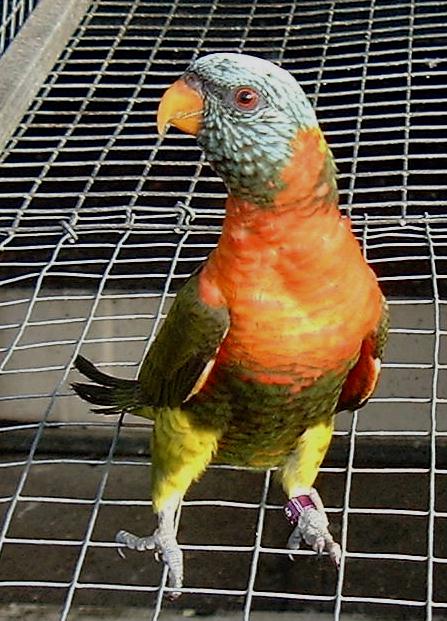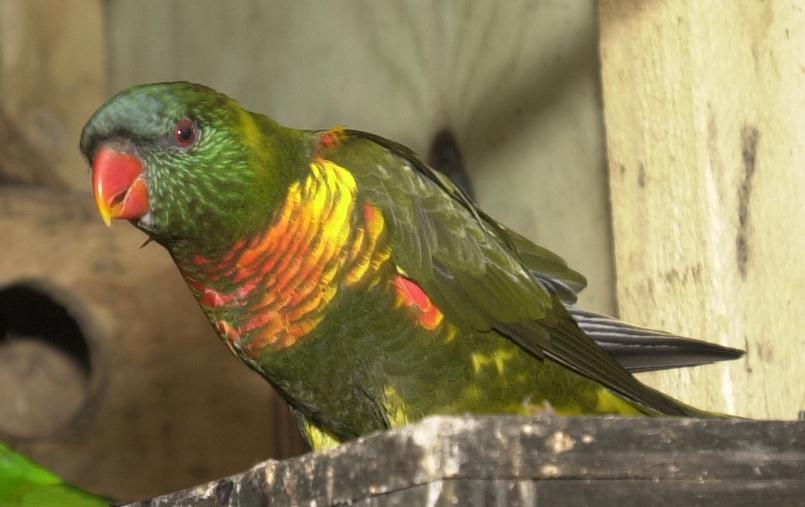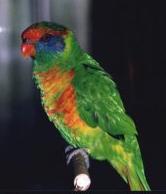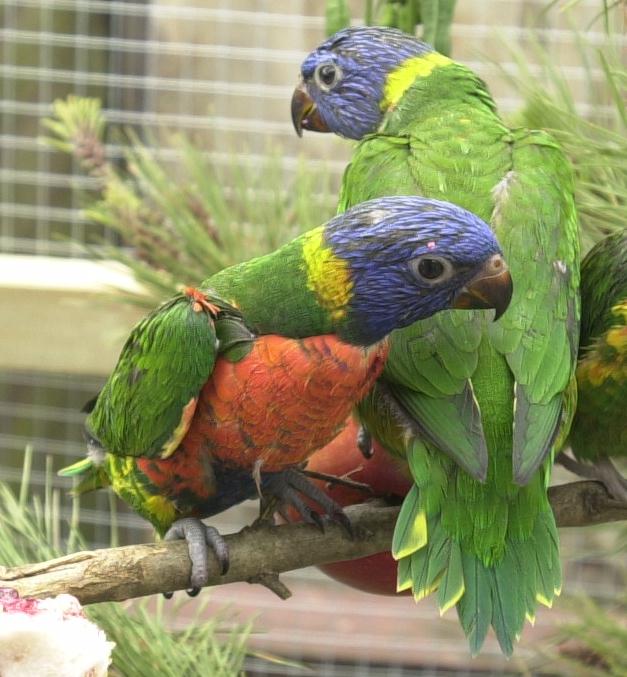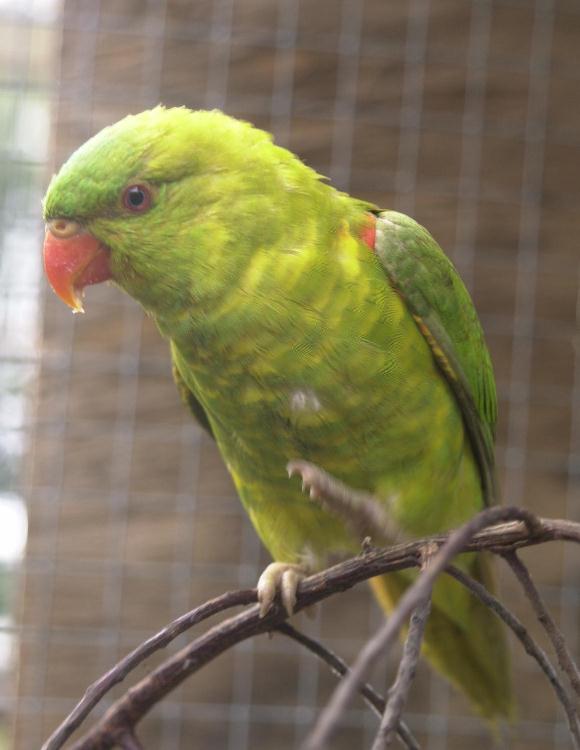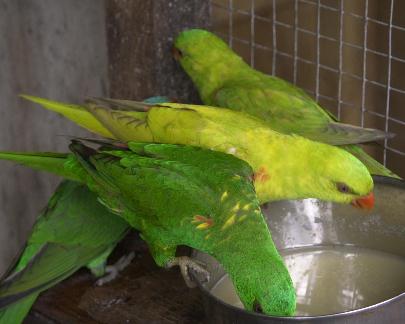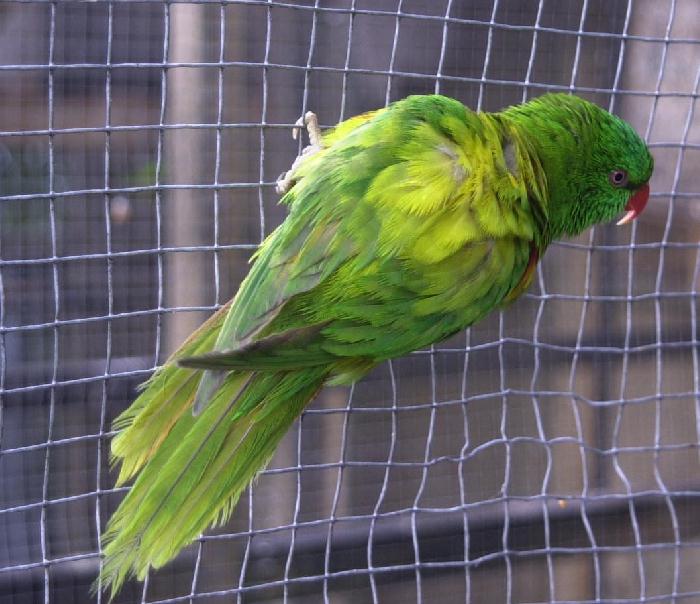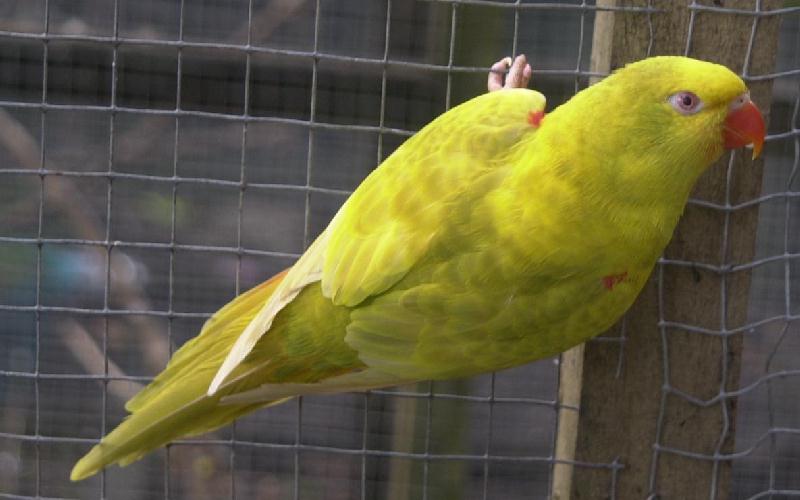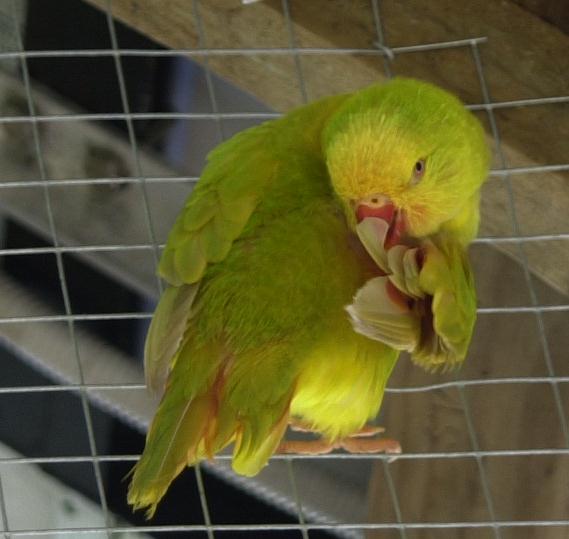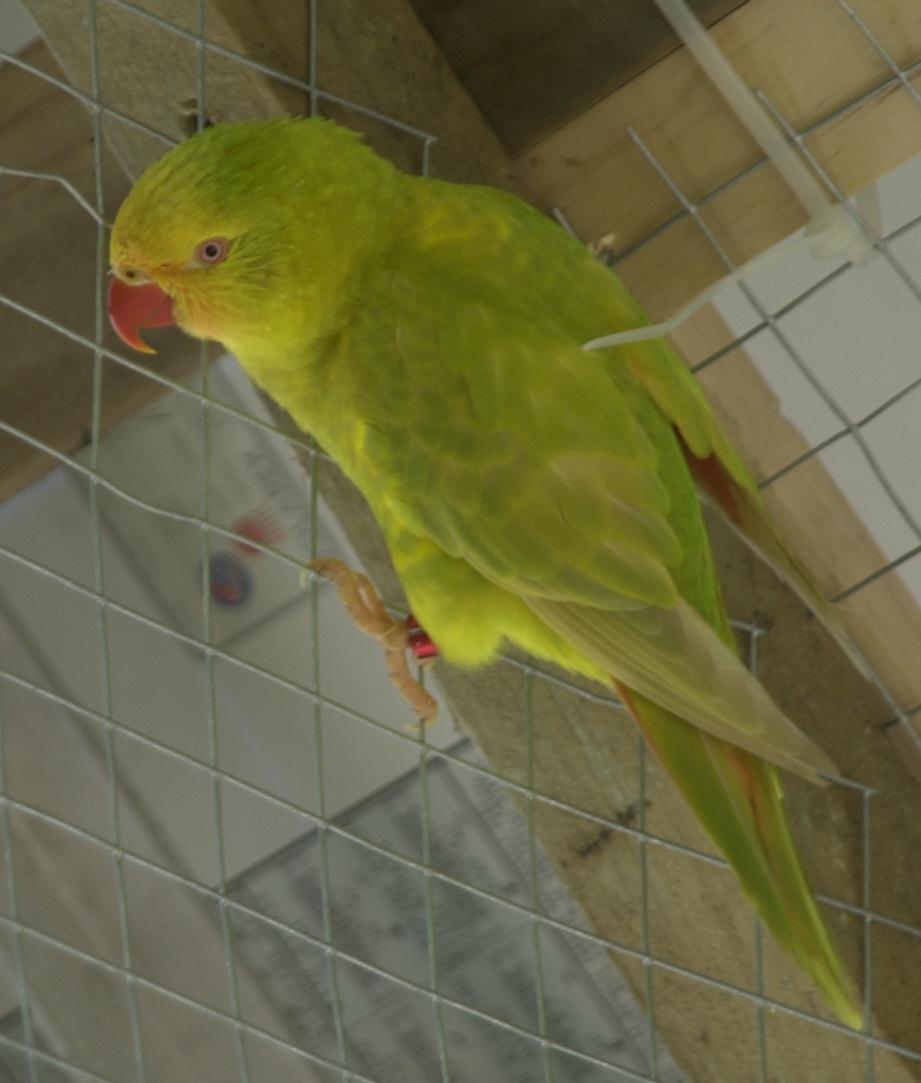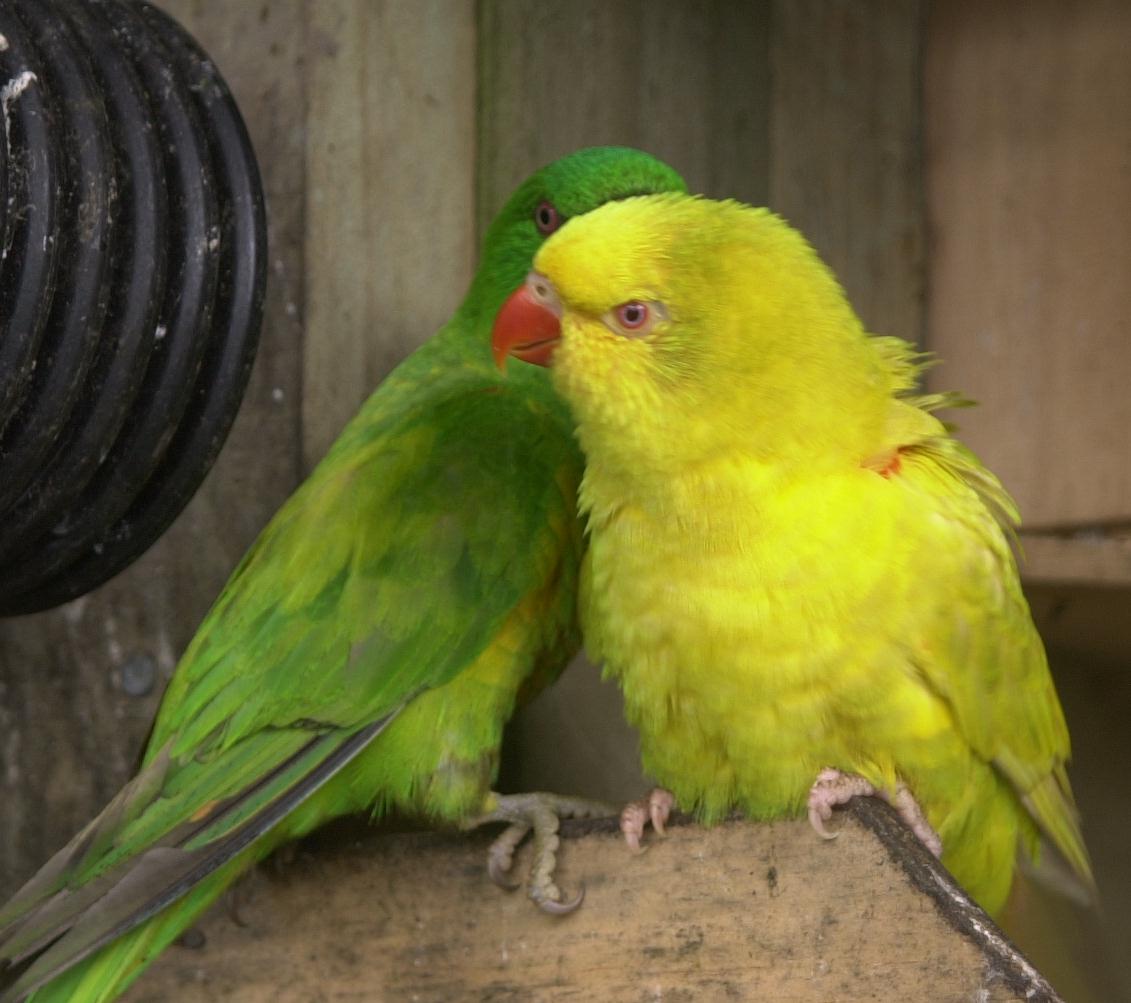HYBRIDS and MUTATIONS
This section of the Lorylink is not intended to be a detailed explanation
of possible hybrids and mutations in the various lories and lorikeets. The
subject of mutations is the proverbial minefield and anyone interested in
learning more about this fascinating area of lory breeding is recommended to
some of the excellent publications that are available. (see below)
Hybids and Mutations of Lories are Lories that are in general different in
one or more features from the expected 'normal' Lory. The most common feature
difference is in the colour of the plumage and perhaps beak, feet (skin)
and toenail colours.
Sometimes overall body size and weight can be included.
Many breeders purposefully produce hybrids to try and introduce certain
colour genes to a type of lory that would not naturally have that colour gene.
This has recently, within the last year or so, led to some quite beautiful
colour variations of well known and popular lorikeet breeds such as
Rainbow lorikeets and Red-collared lorikeets.
Many breeders, especially in Australia, are now advertising these new
colour variations - eg Lutino/Yellow/Mustard/Cinnamon Rainbows and Red-collars.
These are sure to appeal to many people who will be attracted by these
stunning new colour variations.
So far no New Zealand breeders are producing these new variations although
with their success in Australia it will probably not be too long before
some of these colour variations become locally avialable.
There is no doubt that producing hybrids and mutations in lories is seen as
a major revenue earning stream by many breeders. Producing and establishing
the unusual is the goal.
Below: Grey-green (Olive) mutations
A grey-green Webers Lorikeet |
A grey-green Red-collared Lorikeet |
Hybrids
Lory hybrids are the result of cross breeding different types of lory. Most
breeders consider this an unacceptable practice because the result is an
unnatural lory, one that would be most unlikley to occur in nature.
However, after saying this, some hybridisation does occur in nature and
examples are reported from
Australia where different types of lories, that usually share the same
geographic areas, food sources, and flock together
have interbred to produce naturally occuring hybrids.
Examples reported are cross-breeding between Rainbow lorikeets/Red Collared
lorikeets, Rainbow lorikeets/Scaly-breasted lorikeets and Scaly-breasted
lorikeets/Musk lorikeets.
It is unlikley that such hybrids do become very common for several reasons:
- Hybrid lories appear to have a lower success rate at producing fertile eggs.
- The hybrid effect would be bred out over several generations of birds as these
pair with other normal mates.
- These birds are much easier for raptors and other predators to select from a
flock of normal lories.
This leads to an interesting point that many aviculturists believe the
grey/green (often called Olive) colour in lorikeets, which only occurs
naturally with Scaly-breasted lorikeets, has been introduced into Rainbow,
Musk and
other types by cross-breeding with grey/green Scalies.
Some New Zealand breeders have or are currently trying to introduce this
olive colour into Rainbows and Musks as it is considered not to be a totally
unnatural process since it has occured in wild populations of birds.
The image below left shows a hybrid olive Scaly/Rainbow lorikeet, this bird is a
cock and size and weight is between that of an adult Rainbow cock and an adult
Scaly cock. This cock bird cold be used to try and produce an Olive rainbow
and the next step would be to mate him with a normal rainbow hen.
The image below right is the result of a deliberate attempt by a breeder to
introduce the grey-green (olive) plumage colour into musk lorikeets. This hybird
has the grey-green plumage from its scaly parent and the red head patch from
its musk parent. (an interesting note here is that the side cheek red patches
from the musk are missing in this hybrid proving that there are separate genes
in the musk lorikeet that produce the head and side cheek red patches).
The breeding plan is to now mate this cock bird with a hen
musk and try to get offspring closer to a musk but with grey-green plumage.
This may take several generations of breeding experiments before a musk
with grey-green plumage is successfully produced.
At right is a cross bewteen a Musk and Rainbow lorikeet. This was not a
deliberate breeding plan but rather what was thought to be two females
together turned out to be a male and female who bred.
Hybrid Rainbow/Olive Scaly |
Hybrid Olive Scaly/Musk |
Hybrid Rainbow/Musk |
The image below shows two hybrid nestmates that are almost red-collars. The
male parent is a red-collar but the female is more a rainbow although she is
also likely a hybrid as she lacks many of the rainbow features (eg no green
collar). The interesting feature of these two hybrids is that apart from the
collar being yellow they are in every other way red-collars. Even the yellow
collar is gradually starting (at fringes) to become orange/red. Several months
afer his image was taken he collars are still largely yellow. Another pair
of young from the same parents are almost complete red-collars with a 90%
red collar with just specks of yellow.
Hybrid Red-collar/Rainbows |
Mutations
Mutations are naturally occuring genetic variations. With lories the interest
is in coloured mutations which is usually seen as a difference in plumage
colour. Many aviculturists strive to
produce mutations because of their uncommon plumage colours, often striking
colours, rarity and not least the fact that mutations can command a much
higher sale value than 'normal' coloured birds.
Some breeders have created a new line of mutations in some lory types by
hybridising a colour muatation from one type into a different type of lory.
Many breeders consider this type of unnatural hybrid/mutation production as
unacceptable practice although many others see it as creating many new
attractive variations of well known lories and lorikeets.
In nature, mutations are constantly occuring but with lories, colour mutations
are not very common (with the one possible exception of the grey/green colour
mutation in Scaly lorikeets). This is probably because of the large gene-pool
available with wild flocks of lories and naturally occuring mutations are
'bred out' quite quickly. In captivity, with the available gene-pool being
much smaller and with inbreeding more likely, there is a much higher
possibility of colour mutations in the captive population.
Also in nature the colour mutations would be much less likely to survive the
attentions of raptors and other predators. (evolution's natural selection
process!)
Colour mutations have a much higher chance of becoming established in
aviculture as breeders become more knowledgable at pairing birds to promote
the mutation. Breeding a colour mutation is not a simple matter even if the
breeder has a bird showing the mutation and the process to reliably produce
colour mutations can take many birds and many years to establish.
The method by which colour genes are passed on from parents to
offspring can mostly be grouped into two categories. Known as sex-linked and
recessive.
Sex-linked means that the inheritence of the genes is dependant
on the sex of the parents.
Recessive means that either parent can pass on the genes to its offspring.
Establishing which method applies enables breeders to determine the best
pairings of birds to create colour mutations. Often this will require
breeding experiments.
Once it is known if the sex-linked or recessive category applies then there are
simple rules that can be applied to determine the outcome of breeding.
If a bird visually shows to be a colour mutation then it is known as a
visual - eg. A yellow scaly.
A bird with normal colour but known to be carrying colour mutation
genes is known as a split - eg a green scaly with the yellow gene would be
described as a yellow-split or split-to-yellow.
Sex-linked
With sex-linked rules only males can be splits, all females will either be
visuals or normals.
A visual male paired with a visual female will produce 100% visual offspring -
eg. a yellow male paired with a yellow female will always produce yellows.
A visual male with a normal female will produce visual females and male splits.
A split male with a visual female will produce visual males, split males, visual
females and normal females.
A split male with a normal female will produce visual females, normal females,
split males and normal males.
A visual female with a normal male will produce split males and normal females.
Using these simple rules birds can be paired to increase the chances of
producing visuals, the ultimate goal of may breeders. Starting with a male
bird that is a colour split the theory is that it should only take several
generations to produce visual males and females and therefore create an
established breeding pair that always produce visuals. Unfortunately the
theory does not always work out so easily and with lorikeets (eg Scaly)
it can prove quite difficult to get that visual male bird, the basis for
establishing the colour mutation.
There is also the problem of in-breeding and unless at least two, prefereably
more, separate colour mutation blood lines are available
then at least two generations of in-breeding will be necessary to establish
the colour mutation. In-breeding will present its own problems as any potential
genetic problems could become apparent and raise issues that prevent the
colour mutation line becoming strong and established.
Recessive
The most common of the colour mutations associated with Lories are described
below using the Scaly Lorikeet as an example of how these colours are
applied.
- Grey-Green (aka Olive but this incorrect naming for this mutation)
This mutation is originally though to have come from Scaly lorikeets and is
reasonably common in wild populations. All normally green plumage is replaced
with
olive-green coloured plumage. This mutation is dominant, meaning that when it
is present the bird colour is always grey/green.
Both sexes can carry the colour mutation genes.
Visuals can only be produced when both parents have the (same) colour mutation
genes.
If the male and female are both visuals then 100% of the offspring will be
visual. (this is the same rule for sex-linked)
If the male and female are both splits then the outcome will be
25% visuals, 50% splits, and 25% normals. These figures have been calculated
from long term breeding patterns (ie statistics!)
A split paired with a non split will produce normals and splits but no visuals.
Grey-green scalies are quite common in New Zealand and a few grey-green rainbows have
been available although, as yet, no grey-green musks or red-collars are known to be here.
(The background tile pattern to this page is an grey-green Scaly lorikeet)
The olive scaly only appeared in New Zealand aviculture several years ago
in the mid 1990s. These mutations sold for up to NZ$3000 each but as they
became more readily available prices have reduced to about NZ$180 each which
is just slightly more than the average NZ$150 for a green Scaly, although
by 2001 prices are starting to rise to $200 and $250.
- Lutino
This is overall bright yellow plumage with white feet, toenails, legs and
white on flight feather edges and ends. Eyes are always a bright pink colour.
Beak is bright orange.
- Yellow
Overall yellow plumage, white feet, toes and white flight feather edges
but with eyes red, ruby, brown through to normal black. The yellow is just
about identical to the lutino except for the non-pink eyes.
- Cinnamon
This is a tan or brown mutation.
With normally green birds this mutation shows as an overall yellow plumage with
overlaying areas of light green (lime?) coloured plumage. The plumage can vary from almost complete green over the underlying yellow, through light green to
almost totally yellow with just a hint of the green colouration.
Toes and legs tend
to be light, almost white colour, eyes can be red, ruby, brown through to
normal colour black and beak an orange to horn colour. Normal black areas of
plumage are off-white to tan coloured. Flight feather edges/ends are a tan
to brown colour.
- Blue
The rarest colour mutation in Scalies, the blue, has also never been bred
in New Zealand.
Plumage is light blue overall with white scaly markings on chest. There is
no green present.
There is only one recorded instance of a blue Scaly
lorikeet, in Australia, and apparently the inexperienced breeder failed
to establish this colour mutation, it may now be totally lost.
Note that the blue mutation is quite common in other birds such as
Indian ringneck parakeets.
Shown below are several images of scaly lorikeets, these are all of the
cinnamon type mutation. The two cinnamons are from the same parents but one
has more light green plumage overlaying the yellow. The yellower bird has
since developed more pronounced areas of lighter green plumage but still
appears very yellow. This clearly shows the variation in overall plumage colours
for the cinnamon type mutation. Both have been dna sexed and are hens.
In this image the more green hen is about seven months old and the yellower
hen is just five months old.
The centre image shows the two cinnamons with a normal green scaly (front)
and highlights the plumage colour differences between the three birds.
So far all of the known Scaly lorikeet yellow/cinnamon mutations appear to
be using the sex-linked inheritence rules. Despite several breeders having
spent several years trying to establish this mutation in Scalies there
appears to have been no success in producing a visual yellow, lutino or
cinnamon male - or at least no breeder is claiming to have a visual
male.
Cinnamon mutation Scaly lorikeet |
Two cinnamon mutations with green Scaly |
Cinnamon mutation Scaly lorikeet |
Below are further images of cinnamon mutation scaly lorikeets. On the right is
an almost yellow four year old hen, note her white flight feathers, white
tonails, pink skinned feet and the area of red tinged plumage around her beak.
Although not discernable in the image her eyes are a ruby red colour.
At left is a cock bird that is a 'Dilute' mutation scaly.
He has a peculiar mix of
green with areas of yellow. Note his normal green head but then the areas
of yellow on his back and the mixed yellow/green tail plumage. He has the
normal scaly yellow barring on green chest although the yellow areas
are much broader and underneath to his tail is a very mixed light green and
yellow. His toenails are quite strange as some are black and others are
very light almost white coloured.
The lower two images are of a 18month cinnamon hen, she has distinct light green over yellow plumage. The off-white to tan coloured flight feathers are seen clearly as she preens them. Her toes are white, feet skin a pink colour and she also has a red tinged area of plumage surrounding her beak. She is not related to the older cinnamon hen in the upper image.
Cinnamon hen and Dilute cock Scalies |
4year Cinnamon hen Scaly |
18month Cinnamon hen Scaly |
18month Cinnamon hen Scaly |
Dilute male and cinnamon hen Scalies |
Dilute male and cinnamon hen Scalies |
Someone has just pointed out to me that the above images of cinnamon scaly
lorikeets seem to have a problem. The three images of the 5 and 7 month old
cinnamons show they have yellow plumage with varying degrees of overlaid
light green (lime)
coloured feathers, this is apparently normal expected cinnamon colouring from
a normal green bird.
However the image of the 4year old cinnamon shows a bird which also appears
be a cinnamon but this time the plumage is again yellow (more so than the
upper two) but the overlaying green plumage has more of a grey-green (olive)
colour. This may be indicating that there are other grey-green genes involved.
The last two images (above) show the 18month cinnamon where the plumage is
definitely yellow with a green overlay.
References/Books
Below are listed some recomendations on further reading on the subject of
colour mutations in birds. These will almost certainly always apply to colour
mutations in lories and lorikeets.
This link to the Avian Health Chapter of the Australian College of Veterinary
Scientists gives an excellent scientific explanation of colour genetics in
parrots.
Avian Genetics

|
A new publication in the 'Guide to' series from ABK Publications Colour Mutations & Genetics in
Parrots ISBN 0957702469 (paperback) ISBN 0957702477 (hardback) |
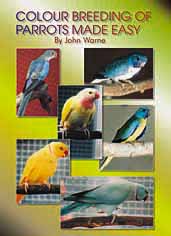
|
A locally New Zealand published book Colour breeding of parrots made easy
by John Warne of the NZ Parrot Society. This is an excellent text full of
tables and charts that detail the outcome of colour mutation breeding in
parrots. |
T.Bastiaan &zn
Lijsterbesstraat 42
8091 TK WEZEP
Holland
Tel or Fax 03837 - 62632
This should be available in Australia from
Neville Armstrong
Tel 02 4962 1858
AU$75 plus P&P

|
The Oct-Nov 2001 (Volume 14 Issue 11) of Australian Birdkeeper contains an
excellent article 'Lutino Red-collared Lorikeet'. The editorial is interesting
in pointing out the dilema that many breeders (and magazine editors!) have in
supporting or seen to be approving of the breeding of unnatural bird mutations.
The lutino red-collars have been the result of hybridising with lutino
Scaly-breasted lorikeets to introduce the lutino genes to the red-collars. |
These pages on lory mutations are intended to be a very simply introduction to
this subject. If you are interested in discussing lory mutations further or
have any information you can add then please contact:
David Dix (dgd@kcbbs.gen.nz)
Contact us

Lorikeet pictures from Lorraine Blakely and David Dix
Tile Pattern: Grey-Green Scaly-breasted lorikeet.
Page written by David Dix, last modified: 27 October 2002.


